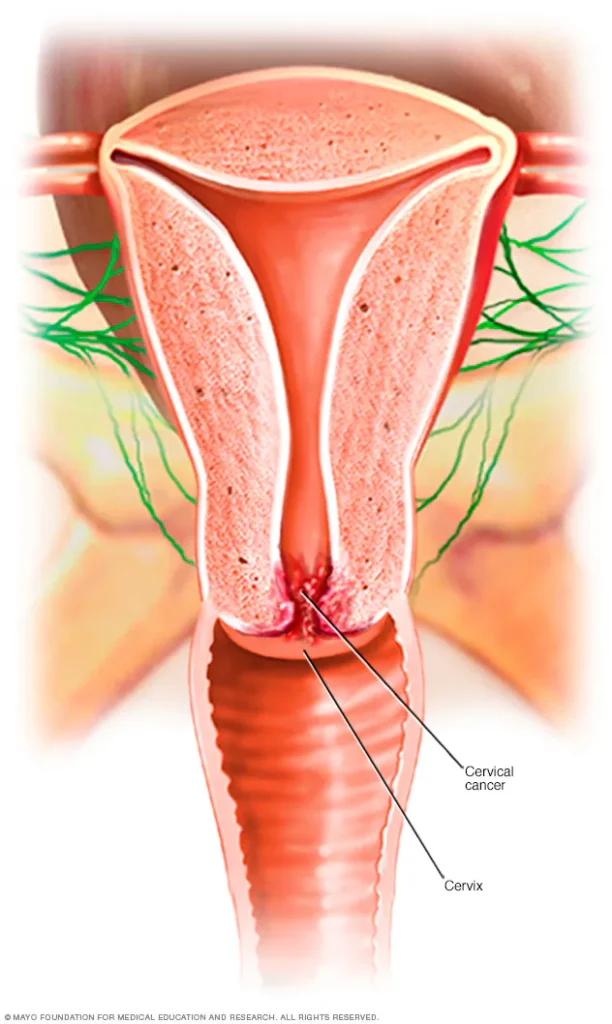Cervical Cancer: Understanding a Preventable and Treatable Disease

Introduction
Cervical cancer is a significant health concern affecting women worldwide, characterized by the abnormal growth of cells in the cervix. Early detection through regular screenings and vaccination against human papillomavirus (HPV) can dramatically reduce the incidence and mortality associated with this disease. This article explores cervical cancer’s causes, symptoms, diagnosis, treatment options, and ongoing research efforts to improve outcomes for those affected.
What is Cervical Cancer?
Cervical cancer originates in the cervix, the lower part of the uterus that connects to the vagina. The two main types of cervical cancer are:
- Squamous Cell Carcinoma: This type accounts for approximately 80-90% of cervical cancer cases and arises from the thin, flat cells lining the cervix.
- Adenocarcinoma: This less common type originates from glandular cells in the cervix and accounts for about 10-20% of cases.
Cervical cancer typically develops slowly over time, often starting with precancerous changes in cervical cells that can be detected through screening.
Historical Background
The history of cervical cancer awareness has evolved significantly over the past century. In the early 20th century, cervical cancer was a leading cause of cancer-related death among women. The introduction of the Pap smear by Dr. George Papanicolaou in the 1940s revolutionized early detection, allowing for timely intervention and significantly reducing mortality rates. More recently, the development of HPV vaccines has provided a powerful tool for prevention, targeting the virus responsible for most cervical cancers.
Anatomy and Pathophysiology
The anatomy relevant to cervical cancer includes:
- Cervix: The lower part of the uterus that connects to the vagina.
- Endometrium: The inner lining of the uterus where abnormal cell growth can also occur.
Pathophysiologically, cervical cancer develops through a series of changes initiated by persistent HPV infection. The virus can cause damage to the DNA of cervical cells, leading to abnormal cell growth. If left untreated, these precancerous changes can progress to invasive cervical cancer.
Causes
The primary cause of cervical cancer is persistent infection with high-risk types of HPV. Other contributing factors include:
- Smoking: Tobacco use increases the risk of developing cervical cancer.
- Immunosuppression: Conditions that weaken the immune system, such as HIV/AIDS or long-term use of immunosuppressive medications.
- Long-term use of oral contraceptives: Extended use may increase risk.
- Multiple pregnancies: Having many children may elevate risk levels.
- Age: Women over 30 are at higher risk.
Understanding these risk factors is essential for prevention strategies.
Symptoms and Clinical Presentation
Cervical cancer may not cause noticeable symptoms in its early stages. As the disease progresses, symptoms may include:
- Abnormal Vaginal Bleeding: This includes bleeding between periods or after sexual intercourse.
- Unusual Vaginal Discharge: A watery or bloody discharge that may have a foul odor.
- Pelvic Pain: Pain during intercourse or persistent pelvic discomfort.
- Changes in Menstrual Cycle: Heavier or longer periods than usual.
Recognizing these symptoms early is crucial for seeking medical advice and intervention.
Diagnosis
Diagnosing cervical cancer involves several steps:
- Pap Smear Test: A screening test that collects cells from the cervix to detect precancerous changes.
- HPV Testing: Tests for high-risk HPV types that are linked to cervical cancer.
- Colposcopy: A procedure using a magnifying instrument to examine the cervix more closely if abnormalities are detected.
- Biopsy: A sample of tissue taken from the cervix for laboratory analysis to confirm a diagnosis.
Early diagnosis through regular screening is vital for effective treatment and improved outcomes.
Treatment Options
Treatment for cervical cancer depends on several factors, including the stage of cancer and overall health:
- Surgery:
- Cone Biopsy: Removal of a cone-shaped section of tissue from the cervix; often used for early-stage cancers.
- Hysterectomy: Removal of the cervix and uterus; may be radical if lymph nodes are also removed.
- Radiation Therapy:
- External Beam Radiation: Targeting tumors from outside the body.
- Brachytherapy: Internal radiation where radioactive material is placed directly into or near tumors.
- Chemotherapy: Uses drugs to kill cancer cells; often combined with radiation therapy for advanced stages.
- Targeted Therapy and Immunotherapy: Newer treatments that target specific pathways in cancer cells or help boost the immune system’s ability to fight cancer.
Prognosis and Recovery
The prognosis for cervical cancer varies based on several factors:
- Stage at Diagnosis: Early-stage cervical cancers generally have a better prognosis than advanced stages.
- Response to Treatment: How well a patient responds to treatment can significantly impact recovery chances.
With timely intervention, many women achieve remission; however, regular follow-up care is essential as there is always a risk of recurrence.
Living with Cervical Cancer
Living with cervical cancer requires ongoing management and support:
- Regular Follow-ups: Continuous monitoring by healthcare providers is essential for managing long-term effects and detecting any recurrence early.
- Support Networks: Connecting with support groups provides emotional assistance for both patients and families navigating this condition.
- Lifestyle Modifications: Adopting a healthy lifestyle—maintaining a balanced diet, exercising regularly, quitting smoking—can enhance overall well-being and reduce recurrence risks.
Research and Future Directions
Research into cervical cancer continues to advance our understanding of its mechanisms and treatment options:
- HPV Vaccination Programs: Ongoing studies aim to evaluate vaccine effectiveness across different populations and age groups.
- New Therapeutic Approaches: Research into targeted therapies and immunotherapies holds promise for improving outcomes in advanced cases.
These research efforts are crucial for improving patient care related to this complex condition.
Conclusion
Cervical cancer remains a significant health challenge but is highly preventable and treatable when detected early. Understanding its causes, symptoms, diagnosis, treatment options, and long-term management strategies is essential for patients and caregivers alike. With ongoing research aimed at improving diagnosis and therapeutic options, there is hope for better outcomes for those affected by this challenging condition.
Disclaimer: This article is intended for informational purposes only and should not be considered medical advice. Always consult with a qualified healthcare provider regarding any medical concerns or conditions.
